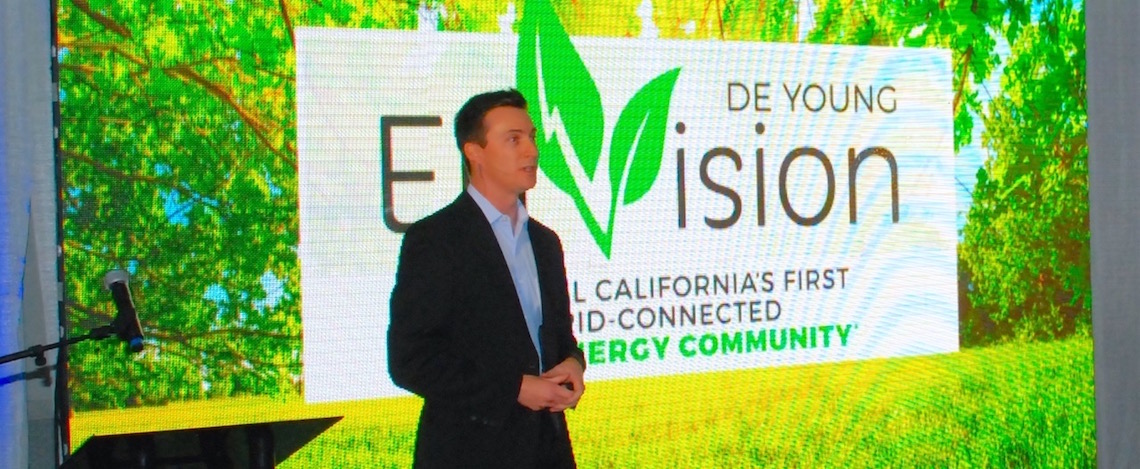
Brandon De Young, executive vice president of De Young Properties, stands in front of a digital screen Tuesday to announce his company’s plan to build a zero energy subdivision in Clovis in which solar panels should generate at least as much energy as residents use. Photo by David Castellon
Written by
After years of building energy-efficient homes, officials for De Young Properties announced their plans to raise their game by building the Central Valley’s first “zero energy” home community just east of Clovis.
The Fresno-based homebuilder plans to construct a 36-home subdivision near East Shaw and North Highland avenues, “each designed with the potential to produce as much clean energy as they consume in a year,” Brandon De Young, executive vice president of De Young Properties, said at a press conference Tuesday at the Clovis Veterans Memorial Building.
That happens through a combination of energy efficiencies in the design and construction of the homes and selection of their appliances, combined with solar panels, explained De Young, who is overseeing development of the new “EnVision at Loma Vista” subdivision.
“We strive to improve the lives of families in the Central Valley, do right by the environment and inspire others to do the same,” he said, adding that the new subdivision should do all three.
In fact, De Young said, depending on how much power is consumed in the new homes, the solar panels could generate even more electricity annually that would be fed into the local electric grid, providing more clean energy to the area.
And besides being a first in the Valley, he said EnVision at Loma Vista will be the largest entirely zero energy subdivision built in California.
De Young, along with a group of energy experts brought to the press conference, noted that most any home could be a zero energy home with the installation of sufficient solar panels, but the challenge us the added costs of the solar equipment and energy efficiencies.
Among the efficiencies planned at the new Clovis subdivision are heat pump water heaters that harvest energy by extracting heat from the ambient air around them, sealed attics and formaldehyde-free insulation with airtight construction.
“It’s the whole integrated design process, which ultimately makes these homes affordable, comfortable and finally showing the great integration of zero net energy homes, and these are all the pieces that we have been able to pull back into the EnVision community,” said Ram Narayanamurthy, technical executive for the Electric Power Research Institute, which has been advising De Young through a program funded by Pacific Gas & Electric Co. to promote low and zero energy buildings.
“For the first time [locally], we have everything designed and built to be zero net energy, integrated and ultimately affordable to your customers.
That’s what makes it a big milestone,” Narayanamurthy told reporters and others gathered for the press conference.
Peter Turnbull, Zero Net Energy Program Manager for PG&E, said the first zero energy house he heard of was in San Jose, but the solar and energy improvements added about $100,000 to its cost.
De Young, whose company has been working on developing zero energy homes for about a decade, said two such homes were built in 2013 and earlier this year at other De Young developments in Clovis to test out the ideas, and now they are ready to go forward with a full subdivision.
As for the added costs, De Young said Tuesday that those costs hadn’t been determined yet, but likely would be just a few thousand dollars, in part because the cost of solar and related equipment has dropped in recent years.
He also noted that the costs for homes in the new subdivision — which will to go on sale Sept. 23 — will start in the low $300,000 range, but the homeowners will not own the solar panels and other equipment.
Instead, Tesla Energy — a division of the electric car company focusing on solar power — will own and install the equipment, for which the homeowners will lease, De Young, said.
He added that the homeowners’ savings on their electrical bills should offset the lease costs, and they will not have to pay to fix or maintain the solar systems, and Tesla would own and be responsible for them.








